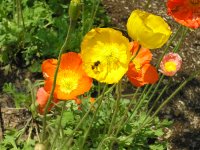 花菱草 hanabishisou 'California poppy' - The common, vulgar, lowly, ubiquitous (but not somniferous) California poppy has a most impressive moniker in Japanese: 花 hana 'flower' + 菱 hishi 'water chestnut' + 草 sou 'grass'. Almost makes you want to ingest it.
花菱草 hanabishisou 'California poppy' - The common, vulgar, lowly, ubiquitous (but not somniferous) California poppy has a most impressive moniker in Japanese: 花 hana 'flower' + 菱 hishi 'water chestnut' + 草 sou 'grass'. Almost makes you want to ingest it.蛍袋 hotaru-bukuro Campanula punctata 'cherry bells' - One flower that seems to bloom with the sprightly bluebells is what looks like its depressive cousin, the hotaru-bukuro 'firefly sack'. One can win many points with dowager gardeners by learning this obscure plant name.
The specific cultivar 'Cherry Bells' was developed in Japan. It is really one of the most pleasing campanulas for tidiness of basal leaves & beauty & colorfulness of large longlasting pendulous flowers. The stems have an appealing flowing tilt which does not look floppy, but permits the "bells" to dangle naturally, so that staking is never required.蓼 tade 'smartweed, knotweed' (Polygonum spp.) - At Uotami ('Fish Nation') izakaya in nearby Kiryu, Gunma Prefecture, over the weekend, the Far Outliers were served an unusual blue-hued dipping sauce for our tasty whole ayu (鮎) 'sweetfish' on a stick. The waitress said the sauce was made from tade, which The New Nelson defines oversimply as 'smartweed' (also known as 'smartass'), a plant with a nasty reputation. But the blue hue turns out to offer a subtle hint. The Japanese variety, also known as dyer's knotweed (Polygonum tinctorium), is one of several secondary herbal sources for indigo dye (Indigofera tinctoria), along with woad (Isatis tinctoria), a favorite of the Picts, who got their Latin name from their fondness for body-dye.
UPDATE: Matt of No-sword adds a tade-related proverb that I neglected to mention: 蓼喰う虫も好き好き Tade kuu mushi mo sukizuki 'Even bugs who eat tade are quite fond of it'—corresponding to "There is no accounting for taste" or De gustibus non disputandem est. I wonder if the smell of tade, like other indigo dyes, is supposed to repel mosquitoes.
No comments:
Post a Comment